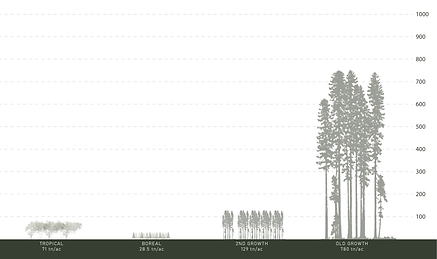RESTORATIVE FORESTRY
A Case for Conservation Through Architectural Intervention
PROBLEM STATEMENT
Of the 2 million acres of old-growth redwood present in Northern California in 1840, only 100,000 remain today. Just 5% of the original total. This rapid and extensive deforestation can be directly attributed to western development that has led to an expansion of agriculture and real estate in the area. While what old-growth forest remains is mostly protected under state and federal legislature, nothing is being done to safeguard this ecosystem from the threats of climate change. Hotter and dryer summers threaten the hydrological balance of an ecosystem where up to 60% of water comes from fog rolling off the pacific, a phenomenon threatened by rising temperatures.
THESIS STATEMENT
Through the implementation of symbiotic design strategies, the California Coastal Redwood and its native ecosystem can be preserved, reinforced, become more accessible to the public, and gain greater traction in our collective social conscience.
BIOLOGICAL PROFILE
The Coastal Redwood is the tallest tree on earth, reaching heights of over 350’ and 35’ in diameter. Their natural habitat consists of a 400 mile stretch of land that hugs the Pacific coastline extending from Big Sur in the south, to the extreme southwestern border of Oregon in the North.
To compare the efficiency of carbon sequestration, I mapped tons of carbon per acre within four different forest biomes. Boreal forests on average sequester 28.5 tons of carbon per acre. Tropical rainforests such as the amazon sequester nearly 3 times that. It is important to note that while there is significant amount of biomass in tropical forests, the rate of decay is also very high, which brings the numbers down. Redwood forests on the other hand, with the enormous size of the trees and the natural stasis of the ecosystem are significantly better suited for carbon sequestration. Second growth forests, which have been logged in the last 200 years house nearly twice the carbon sequestered by a tropical rainforest. Old-Growth forests however, sequester more than 10 times the carbon of a tropical rainforest. Making their preservation critical in our increasingly emissive society.
ECOLOGICAL IMPACT
In addition to their importance in regard to carbon sequestration, the redwood tree is a keystone species within its ecosystem, with hundreds of other flora and fauna dependent on its presence for their survival. Many of the species are endangered and only found within the Redwood Rainforest. Some examples I’ve demonstrated here are the Tanoak, which doesn’t do well in direct sunlight, so it uses the redwood to shelter itself from direct rays. Redwoods themselves, due to their size and longevity, can be colonized by numerous epiphytic plant species. Numerous bird species nest within the canopy; many of which are endangered and found only within Redwood forests. Lastly, the dense upper canopy of the Redwoods traps a lot of fallen plant debris, causing it to decompose into soil within its branches. The importance of the Redwood to this unique ecosystem demonstrates another reason why its conservation is so pertinent.
SITING
When selecting a site to use a case study for this I considered the presence of old growth forest, as well as proximity to urbanized contexts. In addition to the ecological roles of this thesis, creating better opportunities for people to interface with the environment was important to me. This lead to the selection of the Muir Woods National Monument as the ideal site to implement the strategies found in this thesis. Located 10 miles North of the Golden Gate bridge, the monument is the most frequently visited Redwood Reserve in the world with over 1,000,000 annual visitors. In addition to its popularity, the steep canyon proved very difficult to log in the early 20th century, leaving over 40 acres of undisturbed Old-Growth redwood within the monument.
DESIGN
The architecture proposed within this thesis primarily focuses on the study of redwood as a structural material as well as the incorporation of biomimetics to closely mirror the ecological niche of the redwood and support the ecology, all of which to be packaged under formal guise of a tower.
Construction material will be provided by the forest itself. Many old-growth redwood forests posess numerous “Snags” or dead standing trees. these would be logged, processed at a nearby mill, and brought directly back to site to minimize the carbon footprint synonymous with construction will keeping as much carbon within the forest as possible. Structurally, working with redwood poses many difficulties, it’s specific gravity is relatively low, minimizing the strength of mechanical fasteners, meaning that the integrity of the tower would be better served by vernacular joinery. Due to the seismic activity in the region, numerous structural safeguards had to be implemented to ensure the stability of these towers to be scattered throughout the forest. Many of these safeguards were pulled from the Japenese vernacular, wherein wood had historically beeen the sole construction material on the seismically active island. More specifically, the structural program of the pagoda heavily influenced the design of the tower.









